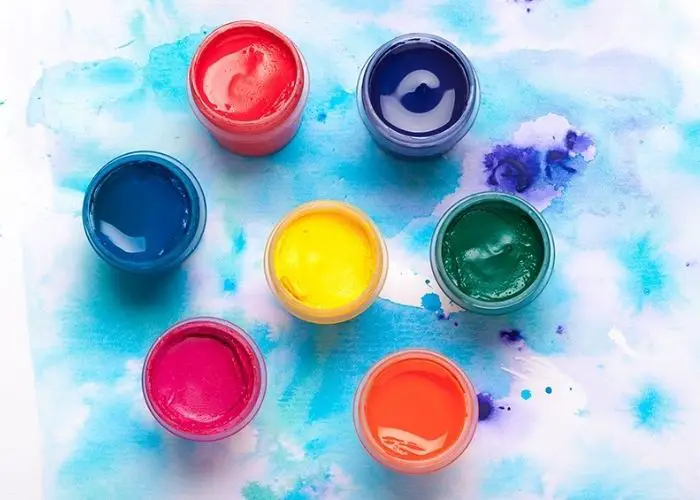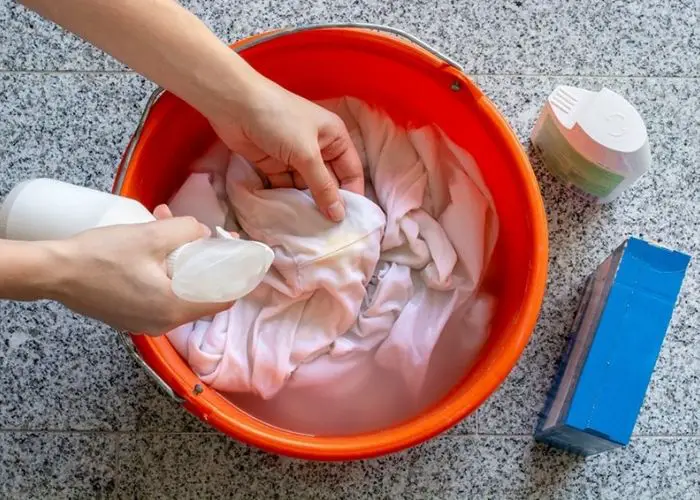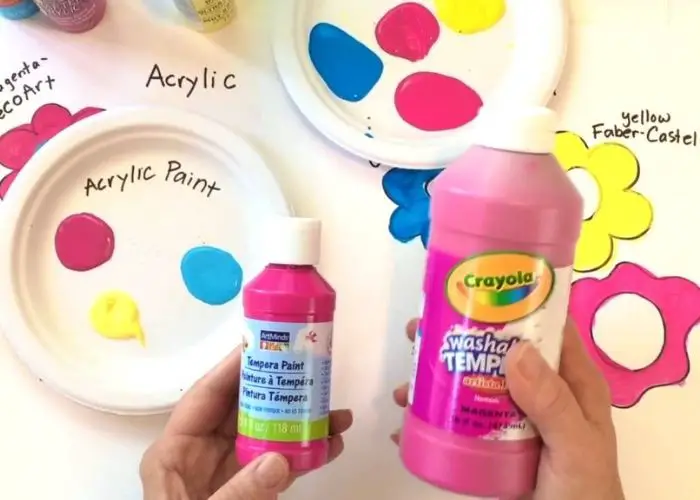What is the difference between tempera and acrylic paint?
In this article, we will discuss the pros and cons of each type of paint and their compositions and other features.
We will also do a head-to-head comparison to help you decide which type of paint is best for your needs.
What is the Difference Between Tempera and Acrylic Paint?
Tempera paint is a type of paint that is made from an emulsion of egg yolk and water. It was the primary form of painting used by artists during the Renaissance. Acrylic paint is a type of paint that is made from a polymer emulsion. It is water-soluble, but becomes water-resistant when it dries.
What is Tempera Paint?

Tempera paint is a type of paint that is made from an emulsion of egg yolk and water, it is also called poster paint. It was the primary form of painting used by artists during the Renaissance.
The word “tempera” comes from the Latin word for “time” because this type of paint dries very quickly.
Tempera paint is not as durable as oil paint, but it is less expensive and easier to clean up.
What are the Pros and Cons of Tempera Paint?
Advantages of Tempera Paint
- Less expensive than oil paint
- Dries quickly
- Easy to clean up
Disadvantages of Tempera Paint
- Not as durable as oil paint
- Can be difficult to work with
What is Tempera Paint Used For?
- This type of paint dries quickly and is often used for children’s crafts projects.
- Tempera paint can be mixed with other mediums, such as watercolors or oil paints, to create different effects.
- It is also possible to thin tempera paint so that it can be used as a stain or glaze.
Learn more, can you use tempera paint on shrinky dinks?
What is Acrylic Paint?
Acrylic paint is a type of paint that is made from synthetic polymer compound and gum arabic binder. This resin is derived from plastic, and it gives the paint a number of unique properties.
Acrylic paint dries quickly, and it can be diluted with water if necessary. It also has excellent adhesion, meaning that it will stick to most surfaces without requiring a primer.
In addition, acrylic paint is very versatile, and it can be used for a variety of different techniques.
As a result, it has become a popular choice for both beginner and experienced painters alike.
Read: Can you put acrylic paint in resin?
What are the Pros and Cons of Acrylic Paint?
When exploring art mediums, one popular choice is acrylic paint.
However, to fully appreciate its utility, we need to discuss the positives and negatives of acrylic.
This examination will provide a comprehensive understanding of its effective use in various artistic scenarios.
Advantages of Acrylic Paint
- Very versatile. Acrylic paint can be used on fabric, canvas, paper, and wood.
- Acrylic paint dries quickly, which is perfect for those who want to work fast.
- It is also non-toxic, making it safe for use around children and pets. In addition, acrylic paint can be easily cleaned up with soap and water.
- Can be diluted with water
- Excellent adhesion
Disadvantages of Acrylic Paint
- May yellow over time
- Not as durable as oil paint
What is Acrylic Paint Used For?
Acrylic paint is renowned for its versatility, enabling artists of all levels, from novices to experts, to explore a wide array of techniques.
This popularity stems from its compatibility with numerous surfaces, raising the question: What can acrylic paint be used on?
Acrylic paint is used for painting walls, ceilings, and trim. It can also be used to create artworks on canvas, wood, or paper.
Interesting Read: Can You Paint on Sketchbook Paper
Is Tempera Paint Acrylic?
No, tempera paint is not acrylic. Tempera paint is made from an emulsion of egg yolk and water, while acrylic paint is made from a polymer emulsion.
Tempera Paint vs Acrylic – Head-to-Head Comparison
Compositions
Is acrylic paint water soluble? What about tempera? One major similarity between these two types of paint in terms of composition is that they are both water-soluble, meaning they can be thinned down using water.
However, they do differ in terms of their base ingredients. Tempera paint is made from an emulsion of egg yolk and water, whereas acrylic paint is made from a polymer emulsion.
The egg yolk helps bind the pigment particles together, resulting in thicker and more opaque paint.
The polymer emulsion used in acrylic paint helps to give the paint its unique properties, such as its quick drying time and excellent adhesion. That’s the reason you might ask yourself sometimes, ‘Why is my acrylic paint watery?’.
Verdict: It’s a tie
Permanence
Permanence refers to how long a paint will last before it starts to fade or degrade.
In general, oil paints are the most permanent, followed by acrylics and then tempera.
However, there are some differences between these two types of paints in terms of permanence.
For example, acrylic paint is more resistant to sunlight than tempera paint. This means that it is less likely to fade or degrade over time.
However, tempera paint is more resistant to water damage than acrylic paint. This means that it is a good choice for paintings that will be hung in bathrooms or kitchens.
Additionally, you can remove tempera paint from clothes and other surfaces, making it a good choice for those who want to be able to clean up easily.
Verdict: Acrylic paint is more permanent than tempera paint.
Lightfastness
Lightfastness refers to how well a paint will resist fading when exposed to light.
In general, oil paints are the most lightfast, followed by acrylics and then tempera.
However, there are some differences between these two types of paints in terms of lightfastness.
For example, acrylic paint is more resistant to sunlight than tempera paint. This means that it is less likely to fade or degrade over time.
Additionally, acrylic paint is not affected by UV light, making it a good choice for paintings that will be hung in direct sunlight.
The fact that acrylic paint is more lightfast, it can retain its color over time, making it a good choice for those who want their paintings to last.
Verdict: Acrylic paint is more lightfast than tempera paint.
Consistency
Acrylic paint is thicker than tempera paint. This can make it difficult to achieve a consistent finish on your project.
Also, because acrylic paint is thicker, it can take longer to dry. Tempera paint is thinner than acrylic paint and has a more consistent consistency.
This makes it easier to achieve a smooth finish on your project. Acrylic paint also dries slower than tempera paint.
Verdict: Acrylic paint wins
Texture when dry
Tempera paint dries to a chalky stiff texture. This can be difficult to work with if you are trying to achieve a smooth finish on your project.
Acrylic paints dry to a soft, velvety finish. This makes it easier to achieve a smooth finish on your project.
Additionally, the soft, velvety finish of acrylic paint makes it more pleasant to touch than the DIY chalky finish paint of tempera.
Verdict: Acrylic paint has a better texture when dry than tempera paint.
Durability
Tempera paint is not as durable as acrylic paint. This means that it is more likely to fade or degrade over time. That’s why it’s mostly preferred for finger painting.
Additionally, tempera paint is more susceptible to water damage than acrylic paint. This means that it is not a good choice for paintings that will be hung in bathrooms or kitchens.
Acrylic paint, on the other hand, is much more durable because it dries into a flexible, water-resistant, and durable surface.
Verdict: Acrylic paint is more durable than tempera paint.
Dry time
Acrylic paint can take up to 1 hour to dry. This can be frustrating if you are trying to work on a project quickly.
Tempera paint dries in as little as 15 minutes. This makes it a good choice for those who want to be able to work on their projects quickly.
Moreover, the fast dry time of tempera paint means that you can apply multiple coats in a short period of time, which can be helpful if you are trying to achieve a certain effect.
Verdict: Tempera paint dries faster than tempera paint.
Opacity
Opacity is the measure of how see-through a paint is. In general, oil paints are the most opaque, followed by tempera and then acrylic.
This means that if you want to achieve a solid color on your project, acrylic paint is a better choice than tempera paint.
However, if you want to be able to see the texture of your project, tempera paint is a better choice.
And why is acrylic more opaque? Acrylic paint is made with pigments that are mixed with plastic. This makes the pigments opaque.
On the other hand, Tempera is made with pigments that are mixed with a binder. This makes the pigments less opaque.
Verdict: Acrylic paint is more opaque
Washability

Is acrylic paint more washable than tempera? Tempera paint is more washable than acrylic paint. This means that it is less likely to stain your clothes or skin hence used as finger paint.
Additionally, tempera paint is easier to remove from surfaces like walls and floors.
Acrylic paint, on the other hand, can be difficult to remove from surfaces and is more likely to stain your clothes or skin.
When it comes to washability, water-based paints are always going to be more washable than oil-based paints.
Verdict: Tempera paint is more washable
Texture
Acrylic paint has a more velvety texture when dry than tempera paint. Additionally, acrylic paint is less likely to crack or flake off of surfaces than tempera paint.
The reason being is that acrylic paint is made with a clear plastic binder. This makes the pigments less opaque and more flexible.
Tempera paint, on the other hand, is made with a binder that is mixed with the pigments. This makes the pigments more opaque and less flexible.
Verdict: Acrylic paint has a better texture when dry than tempera paint.
See Also: How to Seal Painted Shoes to Prevent Cracking
Mixing capability
Mixing capability here means the ability of the paint to mix with other colors and mediums.
This is important for artists who want to create certain colors or shades that are not commercially available.
Tempera paints are generally difficult to mix with other colors and mediums. This is because they have a water-soluble binder which makes them less compatible with other oil-based products.
On the other hand, you can mix acrylic with acrylic medium or or any binding agents to blend colors of your choosing.
Cost
When it comes to the cost of these two products, there is no clear winner.
This is because the price of both tempera and acrylic paints depends on a number of factors such as the brand, quality, quantity, etc.
However, in general, tempera paints are cheaper than acrylics.
Toxicity
Another factor that you might want to consider is the toxicity of the paint. Tempera paint usually contains lead, which can be harmful if inhaled or ingested.
Acrylic paint, on the other hand, is non-toxic and safe for both adults and children.
However, it is worth noting that some brands of acrylic paint may contain harmful chemicals such as cadmium and mercury.
If you are looking for safe paints, here are some eco-friendly acrylic paint alternatives.
Viscosity
The viscosity of a paint refers to its thickness or thinness. This property is important for artists who want to control the amount of paint they are using.
Tempera paints have a higher viscosity than acrylics, which means they are thicker and more difficult to spread.
Acrylics, on the other hand, have a lower viscosity, which makes them easier to work with.
Application / Uses
Another factor to consider is the application or use of the paint. Tempera paints are typically used for school projects, crafts, and murals.
Acrylics, on the other hand, are more versatile and can be used for a variety of applications such as painting canvases, creating mixed media art, etc.
This makes acrylic the best paint for professional artists.
Easy to clean up
Looking for an easy to clean up paint? Look no further than tempera paints! These water-based paints can be easily cleaned up with soap and water.
This is because they have a water-soluble binder. Acrylic paints are not as easy to clean up as they have a polymeric binder.
This means that you will need to use paint thinner or alcohol to remove them from your brushes and other surfaces.
Permanency and varnish
Finally, let’s talk about permanency and varnish. Tempera paints are not as durable as acrylics and are prone to fading and chipping over time.
This is because they have a water-soluble binder, which makes them less resistant to damage. Acrylics, on the other hand, are more permanent and durable.
This is because they have a polymeric binder, which makes them more resistant to fading and chipping.
However, both types of paint can be sealed with a varnish to extend their lifespan.
Other Post: How to Preserve Acrylic Paint
Tempera Paint vs Acrylic Paint Comparison Table
Now that we’ve gone over the main differences between tempera and acrylic paint, let’s compare them side by side in the table below.
| Property | Tempera Paint | Acrylic Paint |
| Composition | Water-based with a water-soluble binder | Made with a polymeric binder |
| Permanence | Not as permanent as acrylics, prone to fading and chipping | More permanent and durable |
| Lightfastness | Good lightfastness | Excellent lightfastness |
| Consistency | Thicker and more difficult to spread due to high viscosity | Thinner and easier to work with due to low viscosity |
| Texture When Dry | Smooth texture when dry | Rough texture when dry |
| Durability | Not as durable as acrylics, prone to fading and chipping | More durable and resistant to damage |
| Dry Time | Quick drying time | Slow drying time |
| Opacity | Opaque | Transparent |
| Cost | Cheaper than acrylics | More expensive than tempera paints |
| Toxicity | Usually contains lead, which can be harmful if inhaled or ingested | Non-toxic and safe for both adults and children |
| Application / Uses | Typically used for school projects, crafts, and murals | More versatile and can be used for a variety of applications such as painting canvases, creating mixed media art, etc. |
| Ease of Clean Up | Easy to clean up with soap and water as they have a water-soluble binder | Not as easy to clean up as you will need to use paint thinner |
Read also:
Can You Mix Tempera and Acrylic Paint?
The short answer is no; you cannot mix tempera and acrylic paint. This is because they have different binders.
Tempera paint has a water-soluble binder, while acrylic paint has a polymeric binder. This means that the two types of paint will not be compatible with each other.
However, you can use acrylic paint over tempera paint. This is because the acrylic paint will act as a sealant and protect the tempera paint from damage.
If you happen to mix the two paints, you will need to use mineral spirits or an alternative to paint thinner to remove them from your brushes and other surfaces.
Tempera Paint vs Acrylic Paint on Canvas

When it comes to painting on canvas, there are a variety of different paint types that can be used.
Two of the most popular types of paint for canvas are tempera paint and acrylic paint. So, what is the difference between these two types of paint on canvas?
When painted on canvas, acryliyc paint will often appear to be more vibrant and have more depth than tempera paint.
This is due to the fact that acrylic paint is a heavier bodied paint, which allows it to retain its shape and form on the canvas surface.
Tempera paint, on the other hand, is a thinner paint that can sometimes appear to be less opaque when compared to acrylic paint.
Another difference between these two types of paint is their permanence. Acrylic paint is much more permanent than tempera paint.
Meaning that it will not fade or change over time on canvas the way tempera paint can.
This makes acrylic paint a good choice for paintings you intend to keep for a long time.
One final difference to consider between these two types of paints on canvas is their consistency.
Acrylic paint is typically more consistent than tempera paint, meaning that it will not separate or change texture over time the way tempera paint can.
This makes acrylic paint a good choice for paintings that you want to maintain a consistent look and feel.
Tempera vs Acrylic Paints on Wood
When painting on wood, tempera paint and acrylic paint behave differently. Acrylic paint is less likely to crack than tempera paint when the wood expands and contracts with changes in humidity.
Tempera paint is a fast-drying, water-soluble medium made from pigments bound in an egg yolk–and–water emulsion.
It dries to a hard, matte finish and is usually used on rigid surfaces. Tempera paint is not lightfast, so it’s best suited for projects that won’t be hung in direct sunlight.
Lastly, acrylic paint is the clear winner when it comes to wood. It’s more durable and has a longer lifespan than tempera paint.
So, if you’re looking for a paint that will stand the test of time, go with acrylic.
How to Make Tempera Paint into Acrylic Paint
If you want to turn your tempera paint into acrylic paint, you need to add a polymer medium to it.
You can find polymer mediums at any craft store. Just mix the tempera paint and polymer medium together in a ratio of 50:50, and voila! You now have acrylic paint.
Tempera Paint vs Watercolor
While tempera paint and watercolor paint are both water-based media, they behave differently. Watercolor paints are made from pigments suspended in a binder of gum Arabic.
It dries to a translucent, matte finish and is best suited for projects that will be hung in direct sunlight.
Tempera paint, on the other hand, is made from pigments bound in an egg yolk–and–water emulsion.
It dries to a hard plastic, matte finish and is usually used on rigid surfaces. Tempera paint is not lightfast, so it’s best suited for projects that won’t be hung in direct sunlight.
Is Tempera Paint the Same as Poster Paint
there is no definitive answer. Both types of paint are water-based and can be used for a variety of applications.
However, tempera paint is typically made with a binding agent such as egg yolk or casein, while poster paint is usually just pigment suspended in water.
As a result, tempera paint is usually thicker and more opaque than poster paint.
Additionally, poster paint is designed to be used on paper, while tempera paint can be used on various surfaces, including wood, glass, and fabric.
Check out the difference between acrylic and poster colours.
How to Use Tempera Paint
Tempera paint is a fast-drying, water-soluble medium made from pigments bound in an egg yolk–and–water emulsion.
It dries to a hard, matte finish and is usually used on rigid surfaces. Tempera paint is not lightfast, so it’s best suited for projects that won’t be hung in direct sunlight.
To use tempera paint, mix it with water until you achieve the desired consistency. Then, apply it to your project surface using a brush, roller, or sprayer.
Once the paint is dry, you can seal it with a varnish or lacquer for added protection. Tempera paint can be used on a variety of surfaces including wood, glass, metal, and fabric.
Further, learn more about the difference between gouache and acrylic paint.
FAQs
Can I substitute acrylic paint for tempera paint?
Yes, you can substitute acrylic paint for tempera paint. Just mix the tempera paint and polymer medium together in a ratio of 50:50, and voila! You now have acrylic paint.
Is tempera or acrylic paint better for canvas?
Acrylic paint is better for canvas because it’s more durable and has a longer lifespan than tempera paint. Additionally, acrylic paint is less likely to crack when the canvas expands and contracts with changes in humidity.
Can I use tempera paint on my face?
No, you cannot. Tempera paint is not safe for the skin. It can cause irritation because of the chemical content. Plus, tempera is not FDA-approved for use on the face, so be sure to practice the right painting techniques so it doesn’t reach your face.
What paint did Bob Ross use?
Bob Ross, the renowned artist, exclusively used oil paint throughout his artistic career. Many art enthusiasts wonder, “Does Bob Ross use oil or acrylic?” However, his preferred medium was oil paint. Bob Ross became famous for his signature ‘wet on wet’ painting technique, a skillful approach that enabled him to complete stunning artworks.
How long does it take for tempera paint to dry?
Tempera paint dries quickly, usually within 15-30 minutes. However, the time it takes for the paint to dry will depend on the type of tempera paint you’re using, as well as the temperature and humidity of your environment.
Can you paint on canvas with tempera paint?
Yes, you can paint on canvas with tempera paint. Tempera paint is a fast-drying, water-soluble medium made from pigments bound in an egg yolk–and–water emulsion. It dries to a hard, matte finish and is usually used on rigid surfaces. However, tempera paint is not lightfast, so it’s best suited for projects that won’t be hung in direct sunlight.
What is egg tempera?
Egg tempera is a type of painting that uses an emulsion of egg yolk and water. It was the primary form of painting until the 15th century, when it was replaced by oil painting.
What is the Difference Between Tempera Paint and Acrylic Paint
So, what is the difference between tempera and acrylic paint? Both have their pros and cons, but acrylic paint is generally more versatile, durable, and permanent.
However, tempera paint is usually cheaper and easier to clean up. Ultimately, the choice of which type of paint to use depends on your needs and preferences.
Thanks for reading! I hope this helped.











Leave a Reply